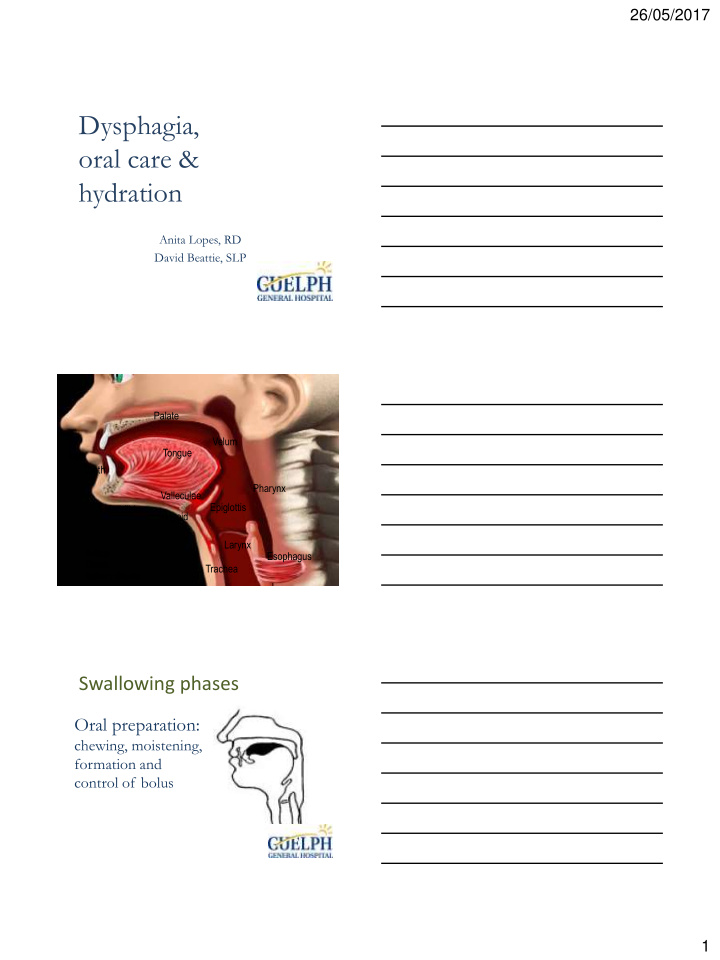



26/05/2017 Dysphagia, oral care & hydration Anita Lopes, RD David Beattie, SLP Palate Velum Tongue Lips Teeth Pharynx Valleculae Epiglottis Mandible Hyoid Larynx Sulcus Esophagus Cheek Trachea Salivary Glands Nursing Best Practices 2 Swallowing phases Oral preparation: chewing, moistening, formation and control of bolus 1
26/05/2017 Swallowing phases Oral propulsive: transit of bolus to posterior oral cavity Swallowing phases Pharyngeal: airway protection, propulsion of bolus into esophagus Swallowing phases Esophageal: transit to the stomach by peristalsis 2
26/05/2017 Normal Swallow https://www.youtube.com/wa tch?v=PwVreNrTKBw Dysphagia Oral Pharyngeal Esophageal Signs of dysphagia Oral stage Not managing secretions Loss of food/fluid from the mouth Unable to form bolus Food residue in cheeks, on tongue or roof of mouth 3
26/05/2017 Signs of dysphagia Pharyngeal stage Frequent throat clearing Coughing, choking Gurgling or wet voice Nasal or oral regurgitation Food “stuck in throat” Absent swallow Aspiration … …can be silent. Nursing Best Practices 12 A present or absent gag … …does not predict or rule out dysphagia or aspiration. 4
26/05/2017 Dysphagia — negative outcomes • Dehydration • ↓ independence • malnutrition • ↓ QOL • skin breakdown • aspiration pneumonia • delayed rehab • death Dysphagia & stroke 50% of stroke patients have dysphagia in the first few days after the stroke. Of these, 1/3 have swallowing difficulties that persist beyond 3 months post-onset. 15 Dysphagia & stroke Bilateral, subcortical or 60-70% brainstem stroke Unilateral 15% hemisphere stroke 5
26/05/2017 Dysphagia & pneumonia 33% of patients with dysphagia develop pneumonia requiring treatment. Stroke & pneumonia 35% of post-stroke deaths are caused by pneumonia. Aspiration on videofluoroscopy http://www.youtube.com/watch?v=1sFNMk87558 6
26/05/2017 Aspiration Dysphagia ↓ Poor secretion Aspiration Management Aspiration Aspiration & Poor oral hygiene ↓ Pneumonia 7
26/05/2017 Why oral care? Pathogens that cause aspiration pneumonia (as well as VAP) can colonize the oropharynx of critically ill patients within 48 hours of admission. Where does oropharyngeal bacteria end up ? 8
26/05/2017 Why oral care? Most bacterial nosocomial pneumonia is caused by aspiration of bacteria from the oropharynx or upper GI tract. Why oral care? Nosocomial pneumonia accounts for 10-15% of all hospital acquired infections. Why oral care? Treatment with oral hygiene alone can reduce occurrence of pneumonia in older adults in nursing homes by 30%. 9
26/05/2017 Why oral care? Patients who have swallowing difficulties are at risk for poor oral hygiene and aspiration . Oral Care Screen stroke patients on admission for obvious signs of dental disease, level of oral care, and appliances. Oral care — considerations Independent? Needs help? Dependent? 10
26/05/2017 — Oral care — considerations Cognition & LOC Activity tolerance UE function Handedness Oral motor function Severity of dysphagia NPO? Patients who cannot eat or drink have the highest oral care needs. What to do? 11
26/05/2017 Swabs …a re for moisture and relief — not for cleaning teeth. Suction at bedside 12
26/05/2017 Suction toothbrush H 2 O 13
26/05/2017 Dentures need cleaning too. Best practice guidelines … final comment … 14
26/05/2017 Thickened fluids …n ot a panacea … 15
Recommend
More recommend